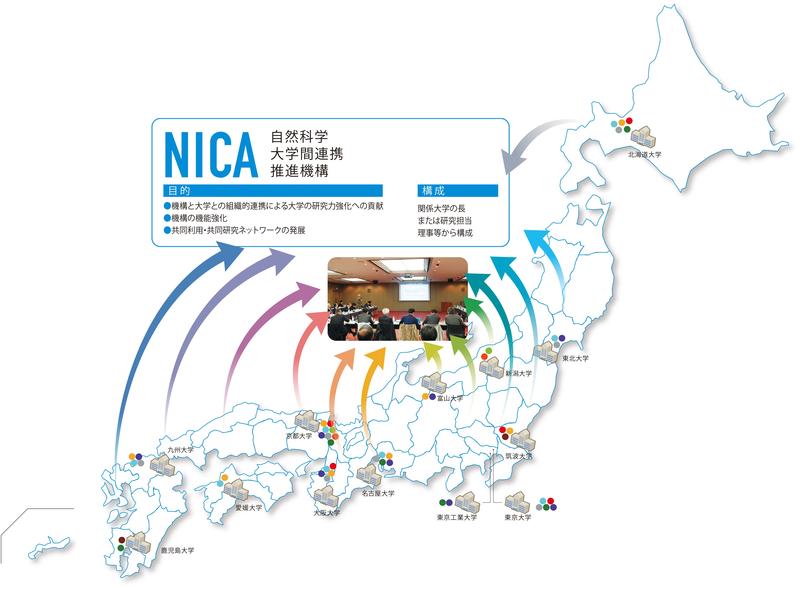本文
About NICA
National Institutes of Natural Sciences has conducted the Network type joint-use and research in order to collaborate with researchers who belong universities and other research institutes in Japan. NINS has newly established the "NINS Inter-University Cooperative Association (NICA)" and conducting large scale research that requires collaboration with universities and other institutes.
There are 13 universities participating in NICA. These universities conduct the "Network-Type joint-use and joint-research" with 5 NINS institutes (NAOJ, NIFS, NIBB, NIPS, IMS) and meet various needs with NICA. NICA has various discussions to further develop their research. In addition, we are actively tackling various issues such as the latest science and technology necessary for research, human resource development to support research, and the development of excellent young human resources.

Networks of NICA
Advanced Bioimaging Support
(NIBB, NIPS)
In the field of life science, imaging techniques are widely used on many scales, from molecules to cells to intact tissues and individuals. The demand for bioimaging has increased in recent years. However, due to advances in imaging technologies, i.e., the diversification and sophistication of special imaging equipment, advances in operations technology, increased costs of advanced imaging equipment, and advances in image analysis technologies, individual research institutes (including universities) have encountered increasing difficulties related to the acquisition and operation of imaging equipment. Our supporting platform, ABiS (Advanced Bioimaging Support), has introduced cutting-edge apparatuses for light microscopy, electron microscopy, magnetic resonance imaging, and other methods. ABiS was established by domestic partner organizations that owned and operated multiple types of advanced specialized imaging equipment, in order to provide comprehensive support for advanced imaging in the field of life science.
National BioResource Project
(NIBB)
<Medaka fish: NIBB>
NIBB maintains MEDAKA resources for research and developing technologies regarding biology, medical science, supplies and environment. Also, we collect, preserve, and provide standard strains , inbred strains, mutants, wild stocks, and related species of MEDAKA as live-resource. Moreover, we provide genome sequence and BAC/EST genome resource. National Institute for Basic Biology and Utsunomiya University practices those provisions.
<Asagao:National Institute for Basic Biology>
NIBB is a sub-center of the National BioResource Project (NBRP) for work concerning Morning Glories. Our group works with the core institute at Kyushu University to gather, preserve, and distribute mutant lines for flower pigmentation and various DNA clones. Please contact Dr. Atsushi Hoshino for information on receiving or depositing resources. Please note our distribution is aimed only at those working within research institutes. Non academics should contact the core NBRP institute directly.
Center for the Development of New Model Organisms
(NIBB)
The Center for the Development of New Model Organisms was established in 2013. Recently, organisms not used for research have been established as new research models. For example, aphids and sea anemones to understand symbiotic phenomena, and beetles to study insect evolution. Currently, we are aiming for research that links seamlessly from information sharing of new model organisms to genetic analysis, genetic modification, and phenotypic analysis.
Interuniversity Bio-Backup Project for Basic Biology
(NIBB)
As a backup base for biological genetic resources, we will back up and store biological genetic resources under research, contribute to the stable development of life science research in Japan, and stabilize various biological genetic resources for which preservation methods have not been established for a long period of time. We are promoting the development of new preservation technology for preservation.
IBBP Biological Resource Backup Storage Electronic Application System (IBBP-easy)
Elucidation of human higher brain function by interactive collaboration research using ultrahigh magnetic field magnetic resonance imaging system
(NIPS)
In light of the dramatic progress in brain function imaging and other related technologies, fragmented observation of the brain as performed in the neuroscience of the past is being rapidly replaced with functional observation of brain function as a whole. In order for Japan to take the initiative in the world's most advanced research in this field, the National Institute for Physiological Sciences, an inter-university research institute with an ultrahigh magnetic field (7 tesla) magnetic resonance imaging (MRI) system, is establishing a foundation for MRI research by forming a network among research institutions in Japan and abroad. This foundation will make the ultrahigh magnetic field MRI system available to universities and other organizations nationwide. At the same time, the institute is training professionals in the skills required to make full use of the system.
Interuniversity collaborative research equipment network
(IMS)
Under the "University Collaborative Research Equipment Network Council," general-purpose research equipment installed at universities nationwide has been revived and refurbished as a leading-edge equipment, and the mutual use of equipment has been promoted and joint research has been promoted. The
Interactive research
(NIFS)
With universities and other institutions with unique fusion-related research facilities National Institute for Fusion Science We are aiming for the further development of fusion research by promoting interactive research with Japan.
Establishing a network of optical and infrared astronomy research and education centers through collaboration between universities
(NAOJ)
National Astronomical Observatory of Japan And each university Inter-university Research Institute Corporation Has built a multi-point and multi-functional observation network with visible light and infrared light that functionally integrates the telescopes of the university and forms a research base that goes beyond the boundaries of universities.
Japanese VLBI Network
(NAOJ)
The Japanese VLBI Network (JVN) is a collaborative project of universities and institutes, which manage VLBI antennas in Japan. The project is led by Hokkaido University, the National Astronomical Observatory of Japan (NAOJ), Ibaraki University, Tsukuba University, the Geospatial Information Authority of Japan (GSI), the National Institute of Information and Communications Technology (NICT), the Japan Aerospace Exploration Agency (JAXA), Gifu University, Osaka Prefecture University, Yamaguchi University, and Kagoshima University.






